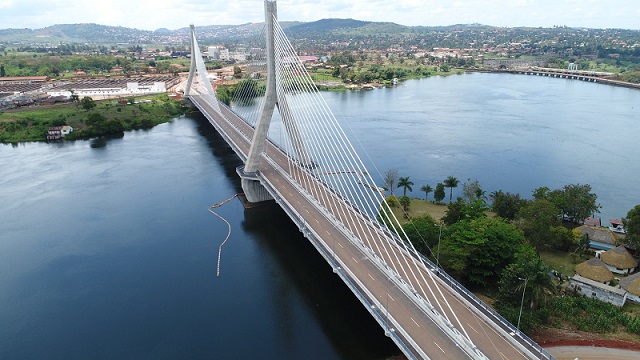
Kampala, Uganda | THE INDEPENDENT | Contractors of the newly built Jinja Bridge used a new form of technology of road surface construction that is still under trial, a report by the Physical Infrastructure Committee of Parliament has revealed.
The new bridge that was built by Joint Venture of Zenitaka Corporation and Hyundai Engineering and Construction Co. Ltd across River Nile in Jinja district cost USD 112 million.
However, the surface of the bridge developed defects 10 days after it was commissioned on October 17th, 2018 drawing public outrage.
As a result, parliament tasked the Physical Infrastructure Committee to investigate and establish what could have happened.
Now, in its findings the Physical Infrastructure Committee notes that although the structure of the main bridge is sound and lacks any defects, the surface of the bridge was affected by the failure of the asphalt concrete and the liquid to bond with the water proofing solution known as Sikalastic.
The report authored by the Committee Chair, Robert Kafeero Ssekitoleko, notes that in order to ensure the longevity of bridge deck, a 4-millimeter synthetic waterproof membrane was used in between the concrete bridge deck and 70-millimeter-thick asphalt wearing course.
However, due to lack of proper bonding, the asphalt surface was unable to withstand the shearing force applied to it by the passage of traffic. The committee then learnt that this technology was new and still being tested there by questioning the decision to apply it on a modern bridge.
Ssekitoleko says works were still ongoing on the trial section using the modified track coat and the trials are expected to go on for between eight to ten months.
He says if the technology doesn’t work, Government and the contractor may be forced to go back to the old technology where no bonding material or water proofing material will be used.
“The implication of reverting to the old system would be that the life span of the newly constructed bridge would reduce from 120 years as envisaged to between 60 and 80 years,” the committee report reads.
The report notes that if the tests yield successful results, the entire surface of the new bridge will be overhauled and worked on at the cost of the contractor.
However, the committee notes that the technology has failed in some places like on the Nagoya express in Japan, the long Bridge in Hanoi Vietnam and Thaun Phuoc Bridge over Han River in Vietnam among others.
The committee deems the technology unsustainable given that it hasn’t been successfully applied anywhere without experiencing defects in a very short term.
The Committee also observed that the consultant and contractor fell short of the task expected of them since they failed to meet the technical specifications to have the best quality materials suitable for the bridge.
The Committee has recommended to Government to review the project to establish the capacity and lifespan of the bridge.
“The Committee feels that there wasn’t enough detailed preliminary investigations done before the inception of the Source of the Nile Bridge project. The Committee is constrained to believe that there was laxity on the side of Uganda National Roads Authority (UNRA) to closely supervise and monitor the work of the contractor on the new Bridge,” reads the report.
The committee notes that even after rehabilitation, which cost the contractor up to US$ 1.3M, the surface of the bridge is so rugged and thus makes it unpleasant to drive due to protuberance on the surface level of the bridge.
Dr. Masooki Tatsumi, the Project Director in Charge of Supervision of the Project, informed the Committee that there is no perfect solution for the bonding of the sikalistic materials, adding that that there is need to test the material and make improvements due to different weather conditions and traffic flow in different countries.
*****
URN
 The Independent Uganda: You get the Truth we Pay the Price
The Independent Uganda: You get the Truth we Pay the Price




no, that bridge’s lifespan is probably less than 3 years if it has not already passed!